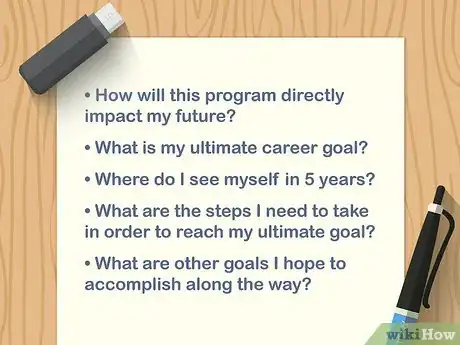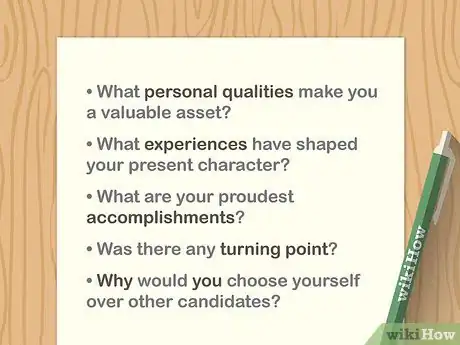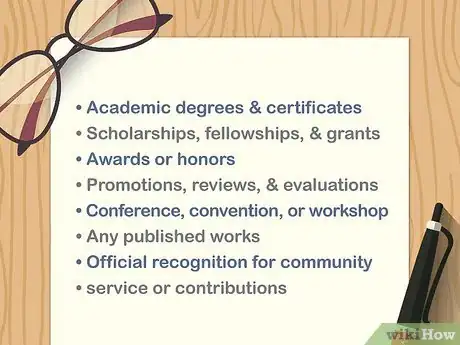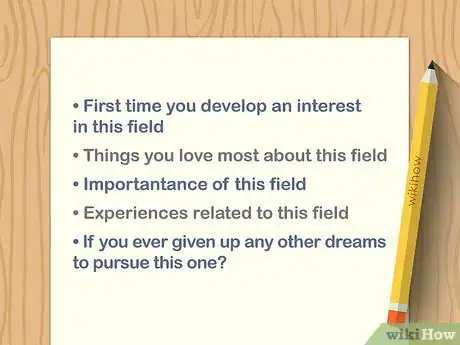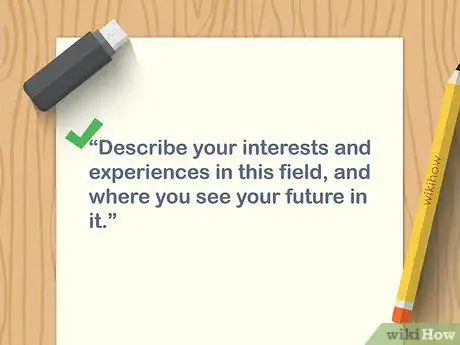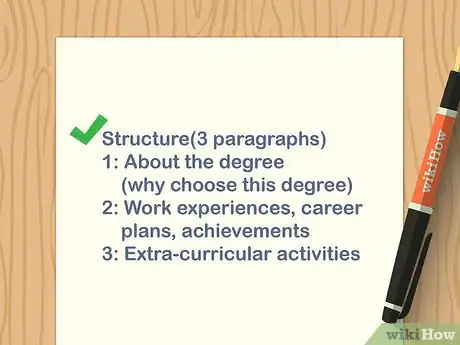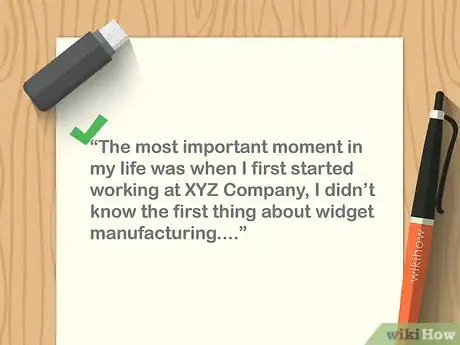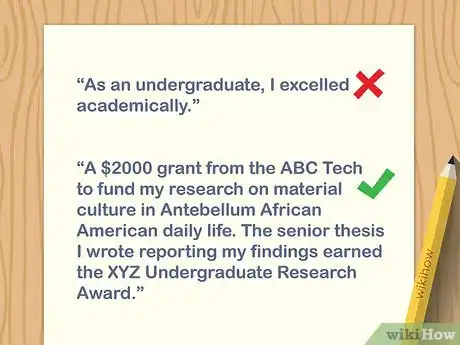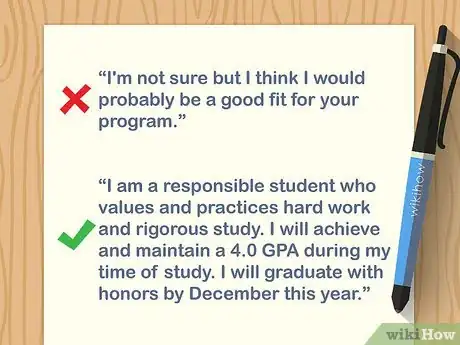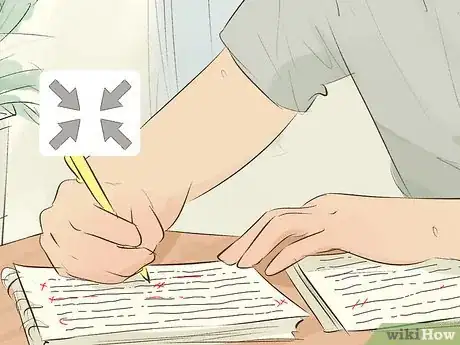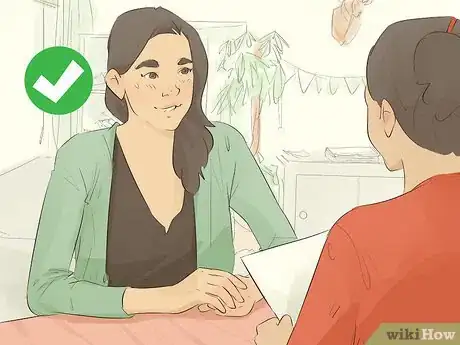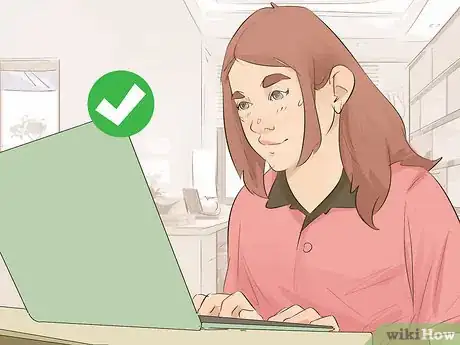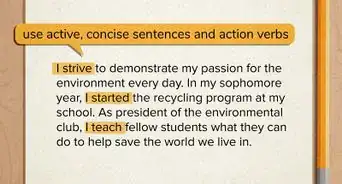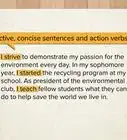This article was co-authored by Christopher Taylor, PhD. Christopher Taylor is an Adjunct Assistant Professor of English at Austin Community College in Texas. He received his PhD in English Literature and Medieval Studies from the University of Texas at Austin in 2014.
There are 7 references cited in this article, which can be found at the bottom of the page.
This article has been viewed 130,188 times.
A personal statement lets an academic institution, organization, workplace, or potential client know more about you and your career or academic goals. Every personal statement will be a little different, but each one should highlight why you're the right fit for the program or position. You should also use your past experiences and accomplishments to support your statement.
Steps
Developing Your Statement
-
1Pick the purpose for your personal statement. The basic structure and purpose of a personal statement can vary based on your goals and your field. You will emphasize different skills and focuses depending on the type of situation for which this personal statement will be used.[1]
- If you're writing a personal statement for undergraduate schools or scholarships focus on how your interests developed, your high school achievements, and your community involvement.
- If you're writing for an undergraduate transfer, focus on your academic and community record with your current school and describe your reasons for wanting to switch universities.
- If you're writing for graduate school, focus on the specific course you want your graduate project or studies to take, your reason for pursuing graduate school, and the undergraduate experiences that have prepared you.
- If you're writing for a job, portfolio, or to gain a particular client, focus on your past work experiences, your relevant academic accomplishments within the past 5 years, and your positive character traits.
- If you've been given a prompt for your personal statement, make sure you have a clear understanding of what it's asking for and what you should write.
-
2Research your target institutions. Start any personal statement by researching the institution or client that will read it. Read over the organization's mission statement, history, and recent newsletters or bulletins to see what they value in a potential student or employee.[2]
- Every institution and organization will look for content specific to their mission and goals in a personal statement. Don't send the same personal statement to different organizations, but instead personalize each statement you write.
- For example, if you're applying to a university that emphasizes community service and involvement, you'll want to emphasize your service work in that statement. Another school may value academics first though. For that school, talk about your coursework and grades.
Advertisement -
3Define your academic and career goals. Your goals are ultimately the focus of any personal statement. These goals let the reader know that choosing you will have a significant impact. You do not need to describe all your goals in your final statement, but list as many as possible as you brainstorm to make your goals clear and specific. To get started, ask yourself a range of questions like:
- How will this university/academic program/scholarship/job position/client directly impact my future?
- What project do I plan to undertake to complete this degree or job opportunity?
- What is my ultimate career goal?
- Where do I see myself in 1 year? 5 years? 10 years?
- What are the steps I need to take in order to reach my ultimate goal?
- What are other goals I hope to accomplish along the way?
-
4Ask yourself why you should be chosen. You will likely have plenty of competition, so you need to thoroughly describe what sets you apart from the rest of the crowd. Before you can convince the reader of your uniqueness, you need to convince yourself. Ask yourself a range of questions, such as:
- What personal qualities (leadership skills, organizational skills, self-control, etc.) do you possess which make you a valuable asset?
- What experiences and beliefs have shaped your present character?
- What accomplishments make you the proudest?
- Have you had any turning points that redirected your life in a positive way?
- Why would you choose yourself over other candidates? Why should anyone else?
-
5List your formal achievements. While you should not include a straight list of achievements in your personal statement, some of your most significant achievements deserve to be mentioned. Writing out a list of your achievements will help you to recall each one and determine which to include. Formal achievements can include:
- Academic degrees and certificates
- Scholarships, fellowships, and grants
- Awards or honors from academic institutions (e.g. summa cum laude, manga cum laude, departmental honors, Dean's List, etc.)
- Workplace promotions, reviews, and evaluations
- Speaking at a conference, convention, or workshop
- Published works in your field of expertise
- Official recognition for community service or contributions
-
6Outline how you reached this place in your life. Jot down a list of experiences and turning points in your life that led you to develop your current career or academic interests. Questions worth asking yourself include:
- When did you originally develop an interest in your field of choice?
- What do you love most about your field of choice?
- Why do you think your field of choice is important?
- What experiences have you had that have provided you with experience in the field?
- Have you given up any other dreams or expectations in order to chase after this one?
-
7Describe any challenges you have faced. Challenges and difficulties can help foster interest in your story and make you more endearing. Everyone loves an underdog, and many people will be willing to assist you if they see that you have already worked hard to reach your current position. Possible challenges to explore include:[3]
- Financial difficulties
- Prejudice
- Social disenfranchisement
- Learning disabilities
- Physical disabilities
- Family problems
- Medical problems
- Unexpected tragedies
Putting Your Personal Statement Together
-
1Read any specific questions mentioned. Sometimes, an institution or organization will provide a list of specific questions or topics they want you to address. If this is the case, review the list carefully so that you can outline answers that directly answer those concerns.
- Often, these questions will be listed directly on the application, or otherwise on the job posting or program web page.
- If you're not sure if your application needs to address specific questions, reach out to the program coordinator or the contact person listed on the posting.
-
2Outline the basic structure of your statement. You will generally only have 1-2 pages to fit all of your information into your statement. Outlining your statement before you write will make sure you cover all your most salient points in your limited space. Try to pick 2-4 critical points to cover.[4]
- Prioritize the purpose of your statement in your outline. For example, if you're applying to a graduate program, your graduate project should be your main focus.
- Write about what interests you. You will be able to write more convincingly and more passionately if you write about events, goals, experiences, or ideas that you already feel passionate about.
- Address issues specifically brought up by the institution or organization. If there are any topics that the reader demands to see, then make sure that those are included in your personal statement.
-
3Create a strong beginning. Your first paragraph must grab the reader's attention. A strong introductory paragraph will clearly introduce the thesis or theme of your personal statement while creating a sense of narrative as if you're introducing a story. Use a personal anecdote to hook your readers.[5]
- Avoid starting with common or cliché phrases like, “The most important moment in my life was when...”
- A better way to introduce that “important moment” would be to simply start describing it. Explain that, “When I first started working at XYZ Company, I didn't know the first thing about widget manufacturing.” Directly break into the narrative instead of alerting the reader that you intend to do so.
- Provide as much detail in the first paragraph as possible. Introduce the main idea of your personal statement and describe how it connects to your narrative. Save any elaborate details or related notes and experiences for the body of your essay, though.
-
4Write a body to support your statement purpose. The paragraphs following your introduction should bolster your statement purpose. Focus each paragraph on a single point, and make sure you relate each point back to your statement purpose or the goals you mentioned.
- For example, for a graduate program statement, your second paragraph could focus on your undergraduate career. Frame your undergrad research, your relevant coursework, and your achievement as tools that helped prepare you for your graduate project.
- Do not be vague or general.
- Do tell the reader about experiences, goals, and ideas unique to you.
-
5Maintain a positive tone. Write in an optimistic, confident tone, even if you're addressing difficult subjects. Your statement should show how you will address problems and create solutions, and your tone should reflect that.
- Avoid uncertain or weak phrasing like, “I'm not sure but I think I would probably be a good fit for your program.”
- Even when discussing challenges or difficulties you faced, focus on your triumphs over those problems.
Revising Your Statement
-
1Expand your statement if it's too short. Your first draft can be as long or short as you need it to be, but many institutions and organizations have a word count or page count limits on personal statements. If your statement is not long enough, you have space to add more supporting information.[6]
- When expanding your personal statement, look for ways to elaborate on the information you already have. Include more specific detail to create a fuller picture. Alternatively, you could introduce another point that contributes to your overall statement purpose.
- While it's not advisable to submit a statement that's too short, you also shouldn't add information just for the sake of having it. If your statement is a paragraph short of a full page but covers all your relevant information, you don't need to expand it.
- Avoid telling the reader why something is important to you. Instead, explain what you've done to show and develop the skill.
-
2Trim down your statement if it's too long. When trimming your personal statement down, scan the essay for any parts that do not directly address your point. You should also cut points that only serve to provide background information.[7]
- You may also consider reducing your number of main points if one point does not seem especially significant.
- Unlike a short statement, a long statement can't be left long. Many application programs won't allow you to press the submit button until your statement is the correct length. That means that if your statement is too long, it needs to be cut down.
-
3Read your personal statement aloud. Reading the piece out loud will give you a more accurate idea of how it sounds. As you read, listen for errors or clunky wording. You should also note any sentences that seem out of place or awkward.[8]
- While listening to your statement, ask yourself if it sounds like your natural voice. If you were describing these things in person, would the way you speak sound like what you wrote?
-
4Ask for constructive criticism. Ask at least 3 people you trust, such as a professor, your business partner, or someone successful in your field, to read over your statement and make suggestions for improvements. Different sets of eyes may offer a more objective analysis regarding your statement's strengths and weaknesses.[9]
- Accept constructive criticism graciously and try not to take anything personally.
- When asking for constructive criticism, first go to professional sources like a high school teacher, a university professor, an internship supervisor, an academic adviser, or a trustworthy colleague.
- After your professional sources have been exhausted, ask friends and family for their thoughts. They may offer great insight regarding the “every-man” opinion, since not all your readers may be familiar with your program or industry.
- It's common to receive conflicting feedback. Think about each of their perspectives to see what may have influenced what they told you. If their experiences don't match your goals, consider if their advice is worth taking.
-
5Proofread at least twice prior to submission. Once you feel satisfied with the content of your personal statement, proofread it once for basic spelling and grammar errors. Then, set your statement aside for 3-4 days, and take a look at it again with fresh eyes. You may catch some errors you didn't find during your first read.[10]
- Once you fix these problems, your personal statement is ready to submit.
Community Q&A
-
QuestionWhat do I include in a personal statement?
 Drew Hawkins1Community AnswerPersonal statements can vary depending on what you're using it for. For example, if you're writing one for a graduate school application, it would include different information than one you would use for a client in a professional context. However, there are a few things that you statement should include. You'll want to include your personal goals, whether they're academic or for your career. You'll also want to include personal qualities that you have that make you a good candidate. Choose specific skills that you have that relate to the purpose for your statement. List any awards or professional achievements to help show off some of your talents and experience. It's also a good idea to describe any challenges you've faced and how you overcame them. It'll humanize you and make your personal statement even more, well, personal! Be sure to include information that's specific to the purpose for your statement. For instance, if you're submitting a statement for a job, you could include information and tasks related to the specific job that show why you're a great choice for the position.
Drew Hawkins1Community AnswerPersonal statements can vary depending on what you're using it for. For example, if you're writing one for a graduate school application, it would include different information than one you would use for a client in a professional context. However, there are a few things that you statement should include. You'll want to include your personal goals, whether they're academic or for your career. You'll also want to include personal qualities that you have that make you a good candidate. Choose specific skills that you have that relate to the purpose for your statement. List any awards or professional achievements to help show off some of your talents and experience. It's also a good idea to describe any challenges you've faced and how you overcame them. It'll humanize you and make your personal statement even more, well, personal! Be sure to include information that's specific to the purpose for your statement. For instance, if you're submitting a statement for a job, you could include information and tasks related to the specific job that show why you're a great choice for the position. -
QuestionHow do you introduce yourself in a personal statement?
 Drew Hawkins1Community AnswerA solid introduction is a great way to get your personal statement rolling and grab the readers attention. A strong introductory paragraph will clearly introduce the thesis or theme of your personal statement while creating a sense of narrative as if you're introducing a story. Use a personal anecdote to hook your readers. Give as much detail as you can. Talk about who you are and how you came to be where you are. The more personal the better. For instance, if you're applying to grad school to be an archeologist, you could talk about how interested in the subject you were as a kid and tell a specific story about how your dad took you to a museum to see dinosaur fossils and you were fascinated. A good anecdote can tell the reader a little bit about yourself while also giving them a compelling story that will make them want to read more.
Drew Hawkins1Community AnswerA solid introduction is a great way to get your personal statement rolling and grab the readers attention. A strong introductory paragraph will clearly introduce the thesis or theme of your personal statement while creating a sense of narrative as if you're introducing a story. Use a personal anecdote to hook your readers. Give as much detail as you can. Talk about who you are and how you came to be where you are. The more personal the better. For instance, if you're applying to grad school to be an archeologist, you could talk about how interested in the subject you were as a kid and tell a specific story about how your dad took you to a museum to see dinosaur fossils and you were fascinated. A good anecdote can tell the reader a little bit about yourself while also giving them a compelling story that will make them want to read more. -
QuestionHow do you end a personal statement?
 Drew Hawkins1Community AnswerThe conclusion of your personal statement is super important. It should very briefly recap everything you've mentioned so the reader is reminded of them. It should also make your case for being the best choice for whatever you're applying for. Use different language to recap your main points so it sounds fresh and is still interesting. Don't simply copy and paste or you could lose your reader's attention. Finish up with a call to action that makes the reader want to choose you. For instance, you could say something like, "That's why I believe I would be a great fit for this position, and I hope you'll choose me for it."
Drew Hawkins1Community AnswerThe conclusion of your personal statement is super important. It should very briefly recap everything you've mentioned so the reader is reminded of them. It should also make your case for being the best choice for whatever you're applying for. Use different language to recap your main points so it sounds fresh and is still interesting. Don't simply copy and paste or you could lose your reader's attention. Finish up with a call to action that makes the reader want to choose you. For instance, you could say something like, "That's why I believe I would be a great fit for this position, and I hope you'll choose me for it."
References
- ↑ https://writingcenter.uconn.edu/personal-statements/
- ↑ https://www.careereducation.columbia.edu/resources/creating-undergraduate-cv
- ↑ https://grad.berkeley.edu/admissions/steps-to-apply/requirements/personal-statement/
- ↑ https://www.careercenter.illinois.edu/instructable/write-your-personal-statement
- ↑ https://www.cmu.edu/hpp/apply-to-schools/personal-statements/tips.html
- ↑ https://www.e-education.psu.edu/writingpersonalstatementsonline/p3_p7.html
- ↑ https://www.e-education.psu.edu/writingpersonalstatementsonline/p3_p7.html
- ↑ https://writingcenter.uconn.edu/personal-statements/
- ↑ https://writingcenter.gmu.edu/guides/advice-for-writing-personal-statements
About This Article
To write a personal statement, start with a strong beginning such as “When I first started working at XYZ Company, I didn’t know the first thing about widget manufacturing” to introduce your theme and grab the reader’s attention. Then, write 2-4 paragraphs to support your statement, highlighting things like your experiences, achievements, and goals. Make sure that you focus each paragraph on a single point, relate each point back to your theme, and keep the tone of your writing positive and confident. For more tips from our Education reviewer, like how to revise your personal statement, read on!


